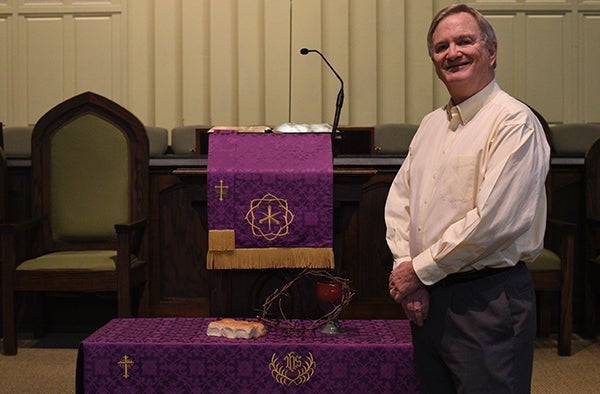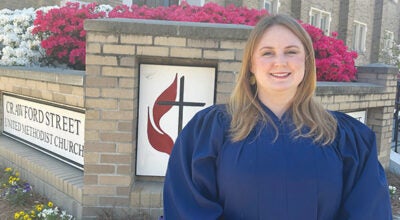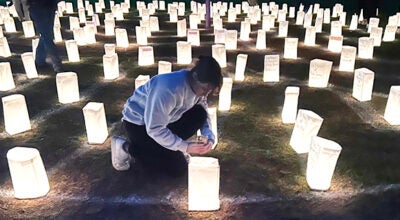Ash Wednesday: Christians recognize beginning of 40-day Lenten Season
Published 6:00 am Wednesday, March 6, 2019

- The Rev. Dr. Tom Atkins stands at the Crawford Street United Methodist Church alter. Today marks the beginning of Lent. (Courtland Wells/The Vicksburg Post)
Today is Ash Wednesday, which marks the beginning of Lent.
This year, the Lenten season will run through April 20 and culminate April 21 — Easter Sunday.
“Although there is no Biblical reference to Ash Wednesday or Lent,” the Rev. Dr. Tom Atkins, who is the pastor at Crawford Street United Methodist Church, said, “Scholars of Christianity date the tradition of a 40-day period of fasting and self-denial back to 325 A.D. at the Council of Nicaea.”
Observed in the Anglican, Eastern Orthodox, Oriental Orthodox, Lutheran, Methodist, Presbyterian and Catholic Churches, Atkins said, “Lent is a time of repentance, fasting and preparation for the coming of Easter. It is a time of self-examination and reflection,” he said, adding, “It is a time to give up things as well as take on new life-giving practices, helping us rid our own selfish desires and ourselves of distractions and by doing so, we seek to live and love as more faithful disciples of Jesus Christ.”
Though Lent serves as a time for self-denial, Atkins urges observers to be mindful of their intent and shared an entertaining, yet thought provoking example of the 40-day period.
“A conversation between a father and his 10-year-old son illustrates the problem in our attitude toward Lent. The father was attempting to explain to his young son the necessity for giving up something for Lent and suggested that the lad give up candy,” Atkins said.
“Quizzed by the boy about this kind of religiosity and what it would bring, the father replied that ‘It will improve your character. You’ll be a better person on Easter Sunday if you give up candy. After all, your mother and I have given up liquor for Lent.’”
Atkins concluded the story by saying, “The boy then said, ‘That’s funny Dad. I saw you and mother having a drink before dinner last night.’ The father replied, ‘That was wine. We gave up hard liquor.’ The lad countered, ‘Oh, that’s good. I’ll give up hard candy.’”
While self-denial is one way to observe the Lenten season, Atkins said it could also serve as a time for a spiritual inventory.
“Lent is a time to literally turn around and realign our lives and focus toward God,” Atkins said. “Lent, which comes from the Teutonic (Germanic) word for springtime, in some ways can be viewed as a ‘spiritual spring cleaning’ — a time for taking spiritual inventory and then cleaning out those things which hinder our relationship with Jesus Christ and our service to him.”
And for those looking at a calendar, the 40-day period of Lent does not include Sundays, Atkins said, “Because each Sunday represents a ‘mini-Easter’ and the reverent spirit of Lent is tempered with joyful anticipation of the Resurrection.”
So why are there 40 days in Lent?
In the Jewish-Christian scripture, Atkins said, 40 has always been a significant number reminding one of the 40 days and nights of rain in the flood that destroyed the earth as sited in the Book of Genesis.
Also, “The Hebrews spent 40 years in the wilderness before reaching the Promised Land. Moses fasted for 40 days before receiving the Ten Commandments and Jesus spent 40 days fasting in the wilderness in preparation for his ministry,” Atkins said. “Most Christians regard this time as the key event for the duration of Lent.”
Atkins said in the early church Lent was a time used to prepare new converts for Baptism.
Symbols Of Lent
There are many symbols that represent the Lenten season, Atkins said, one of which is the placing of ashes on the head or forehead in the Sign of the Cross during an Ash Wednesday service.
“In the Old Testament, ashes represent death and sorrow for sins and serve as a stark reminder of human mortality which is a compelling reason to do penance. In biblical times, once people admitted their sins they covered themselves with sackcloth and ashes as a public admission of guilt, a plea for God’s mercy, a promise to reform, and a pledge to resist future temptation,” he said.
Today, the ashes used in an Ash Wednesday service, Atkins said, come from burned palms from previous Palm Sundays.
The color violet or purple is also a symbol of lent.
“Violet or purple is the liturgical color for the season and symbolizes mourning, suffering, humility, regret, and the willingness to do penance, particularly fasting, Atkins said.
This symbol, he added, is associated with the suffering based upon Jesus’ Passion when the soldiers clothed him in a purple cloak and tortured him.
Other symbols of Lent include barren stones, which represent the desert where the landscape was covered with loose stones, Atkins said.
The stones are a symbol of austerity and rigor, desolation and misery, severity and sadness and the devil used them to tempt Jesus,” by urging him to turn them into bread. Yet, Jesus ultimately made them a symbol for overcoming temptation.
A fish is a Lenten symbol because it represents the obligation to fast, Atkins said.
And incense and praying hands represent prayer, which is the activity that ranks first among the other three traditional practices of Lent —fasting, almsgiving, and works of charity, Atkins said.
“Prayer is the premier way to strengthen one’s relationship with God, and in so doing, to turn away from sin,” he said.
A moneybag or moneybags represents the Lenten practice of almsgiving.
“Lent is both a practical outward experience, as well as an inward spiritual experience, and I try to become more intentional about my growing relationship with my Lord Christ,” Atkins said. “Since 1995, I have reread the Daily Lenten Devotional book by Walter Wangerin entitled ‘Reliving the Passion.’ The book is powerful. I highly recommend it to anyone who is serious about experiencing the spiritual meaning of Lent.”






